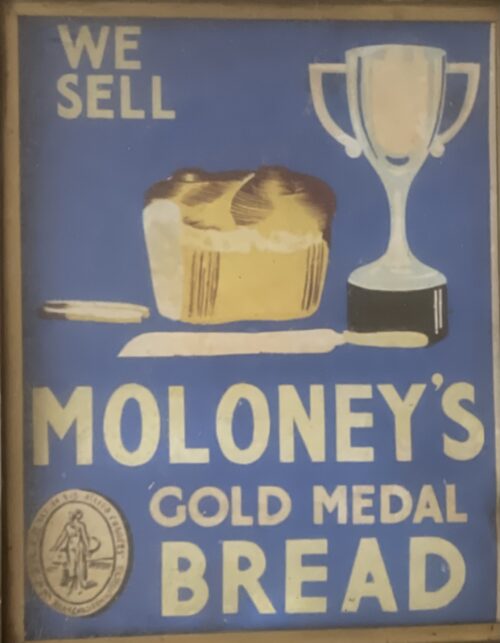-

 65cm x 90cm Banagher Co Offaly Rare example of a very old & impressive advertising print ,depicting a well known type of Port of the time and a nice northern Portuguese vista .Adam Millar's were a well known spirits, wine and cordials merchant in the Liberties section of Dublin.The firm also bottled for such behemoths as Jameson's and Roe's as well as producing their own Black label whiskey until the company's sad closure in the mid 20th century.The practice of merchant bottling was commonplace in Ireland and many of the best known Irish whiskies today started out as such.Jamesons in particular did not officially bottle their own whiskey until 1968 and up to this point offered their products only by the barrel.
65cm x 90cm Banagher Co Offaly Rare example of a very old & impressive advertising print ,depicting a well known type of Port of the time and a nice northern Portuguese vista .Adam Millar's were a well known spirits, wine and cordials merchant in the Liberties section of Dublin.The firm also bottled for such behemoths as Jameson's and Roe's as well as producing their own Black label whiskey until the company's sad closure in the mid 20th century.The practice of merchant bottling was commonplace in Ireland and many of the best known Irish whiskies today started out as such.Jamesons in particular did not officially bottle their own whiskey until 1968 and up to this point offered their products only by the barrel. -

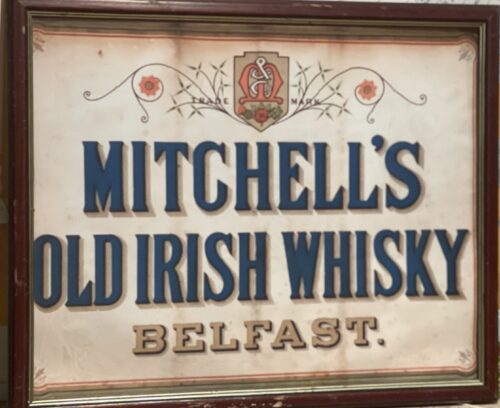 44cm x 65cm Once a giant of the distilling business along with Dunvilles,Mitchell’s fall from grace, like so many other superb Irish distilleries was symptomatic of the economic climate and circumstances of the time. Charles William Mitchell originated from Scotland and took over his fathers distillery in the Campletown area .In the 1860s he moved to Belfast and became manager of Dunvilles Whiskey before establishing his own brand Mitchell & Co tomb St in the late 1860s.A newspaper report in 1895 hailed the virtues of Mitchells Cruiskeen Lawn Whisky,which secured prizes around the world including first place at the New Orleans Exposition.It was a rare Mitchells Cruiskeen Lawn Whiskey mirror that recently commanded £11500 at auction in 2018 following the sale of the contents of an old Donegal public house. Indeed Mitchell’s were renowned for advertising their products on mirrors, trade cards, minature atlas books and pottery to name just a few. Below is the original mirror that was commissioned for their Tomb Street premises on the launch of their Cruiskeen Lawn Old Irish Whisky, late 1800’s. Two were made for the entrance of their Tomb Street premises. Inscribed is the Cruiskeen Lawn poem, with gold leaf barley with green and red in the Mitchell Crest. Definately the holy grail of all mirrors, a true treasure and still survives today in the heart of Belfast and worth the above mentioned princely sum and now probably more !
44cm x 65cm Once a giant of the distilling business along with Dunvilles,Mitchell’s fall from grace, like so many other superb Irish distilleries was symptomatic of the economic climate and circumstances of the time. Charles William Mitchell originated from Scotland and took over his fathers distillery in the Campletown area .In the 1860s he moved to Belfast and became manager of Dunvilles Whiskey before establishing his own brand Mitchell & Co tomb St in the late 1860s.A newspaper report in 1895 hailed the virtues of Mitchells Cruiskeen Lawn Whisky,which secured prizes around the world including first place at the New Orleans Exposition.It was a rare Mitchells Cruiskeen Lawn Whiskey mirror that recently commanded £11500 at auction in 2018 following the sale of the contents of an old Donegal public house. Indeed Mitchell’s were renowned for advertising their products on mirrors, trade cards, minature atlas books and pottery to name just a few. Below is the original mirror that was commissioned for their Tomb Street premises on the launch of their Cruiskeen Lawn Old Irish Whisky, late 1800’s. Two were made for the entrance of their Tomb Street premises. Inscribed is the Cruiskeen Lawn poem, with gold leaf barley with green and red in the Mitchell Crest. Definately the holy grail of all mirrors, a true treasure and still survives today in the heart of Belfast and worth the above mentioned princely sum and now probably more ! -
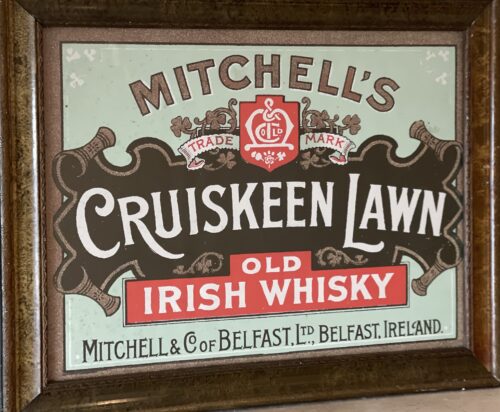
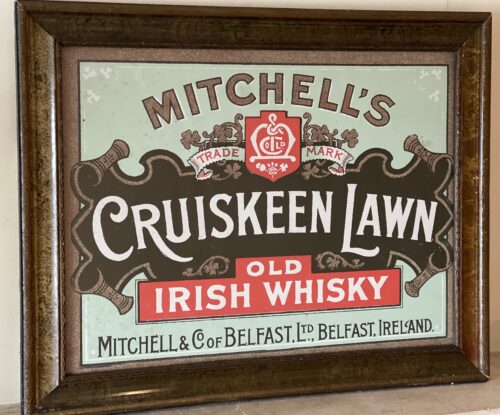 Mitchells Cruiskeen Lawn Old Irish Whiskey Advert. 48cm x 60cm Coleraine Co Antrim Once a giant of the distilling business along with Dunvilles,Mitchell’s fall from grace, like so many other superb Irish distilleries was symptomatic of the economic climate and circumstances of the time. Charles William Mitchell originated from Scotland and took over his fathers distillery in the Campletown area .In the 1860s he moved to Belfast and became manager of Dunvilles Whiskey before establishing his own brand Mitchell & Co tomb St in the late 1860s.A newspaper report in 1895 hailed the virtues of Mitchells Cruiskeen Lawn Whisky,which secured prizes around the world including first place at the New Orleans Exposition.It was a rare Mitchells Cruiskeen Lawn Whiskey mirror that recently commanded £11500 at auction in 2018 following the sale of the contents of an old Donegal public house. Indeed Mitchell’s were renowned for advertising their products on mirrors, trade cards, minature atlas books and pottery to name just a few. Below is the original mirror that was commissioned for their Tomb Street premises on the launch of their Cruiskeen Lawn Old Irish Whisky, late 1800’s. Two were made for the entrance of their Tomb Street premises. Inscribed is the Cruiskeen Lawn poem, with gold leaf barley with green and red in the Mitchell Crest. Definately the holy grail of all mirrors, a true treasure and still survives today in the heart of Belfast and worth the above mentioned princely sum and now probably more !
Mitchells Cruiskeen Lawn Old Irish Whiskey Advert. 48cm x 60cm Coleraine Co Antrim Once a giant of the distilling business along with Dunvilles,Mitchell’s fall from grace, like so many other superb Irish distilleries was symptomatic of the economic climate and circumstances of the time. Charles William Mitchell originated from Scotland and took over his fathers distillery in the Campletown area .In the 1860s he moved to Belfast and became manager of Dunvilles Whiskey before establishing his own brand Mitchell & Co tomb St in the late 1860s.A newspaper report in 1895 hailed the virtues of Mitchells Cruiskeen Lawn Whisky,which secured prizes around the world including first place at the New Orleans Exposition.It was a rare Mitchells Cruiskeen Lawn Whiskey mirror that recently commanded £11500 at auction in 2018 following the sale of the contents of an old Donegal public house. Indeed Mitchell’s were renowned for advertising their products on mirrors, trade cards, minature atlas books and pottery to name just a few. Below is the original mirror that was commissioned for their Tomb Street premises on the launch of their Cruiskeen Lawn Old Irish Whisky, late 1800’s. Two were made for the entrance of their Tomb Street premises. Inscribed is the Cruiskeen Lawn poem, with gold leaf barley with green and red in the Mitchell Crest. Definately the holy grail of all mirrors, a true treasure and still survives today in the heart of Belfast and worth the above mentioned princely sum and now probably more ! -

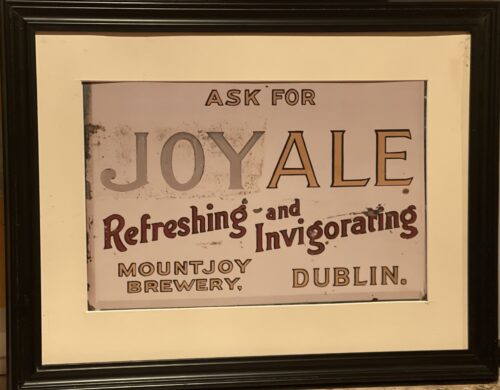 44cm x 52cmMountjoy Brewery Ltd, Russell Street, Dublin, Ireland. Founded 1852. Known as Findlater & Co. until June 1891. Closed 1957. From the Brewery History society Journal Number 91 Founded by Alexander Findlater, a Scottish businessman, in 1852. Primarily a porter brewer but later ale brewers. They enjoyed local, military and export trade with markets in the UK and the colonies. The brewery passed into the hands of Messrs Malone & Blood in 1900 and had by this time become the largest exporter of porter next to Guinness through the port of Dublin. It outlived all its rivals in Dublin apart from Guinness and closed in 1957.
44cm x 52cmMountjoy Brewery Ltd, Russell Street, Dublin, Ireland. Founded 1852. Known as Findlater & Co. until June 1891. Closed 1957. From the Brewery History society Journal Number 91 Founded by Alexander Findlater, a Scottish businessman, in 1852. Primarily a porter brewer but later ale brewers. They enjoyed local, military and export trade with markets in the UK and the colonies. The brewery passed into the hands of Messrs Malone & Blood in 1900 and had by this time become the largest exporter of porter next to Guinness through the port of Dublin. It outlived all its rivals in Dublin apart from Guinness and closed in 1957.Entry in the Trade Mark Registry Registration No : 5,664 Description : Three castles in shield Date of Application : 13/5/1876 Used Prior to 1875? : 10 years
Registration No : 5,665 Description : Crown in shield Date of Application : 13/5/1876 Used Prior to 1875? : 10 years Registration No : 156,739 Description : Label design Date of Application : 26/5/1891 Used Prior to 1875? : Since Aug 1875 Registration No : 372,597 Description : Joy (word) Date of Application : 19/04/1916 Used Prior to 1875? : NO -

 Clonakilty Co Cork 42cm x 30cm
Clonakilty Co Cork 42cm x 30cmJAMES J. MURPHY
 Born on November 1825, James Jeremiah Murphy was the eldest son of fifteen children born to Jeremiah James Murphy and Catherine Bullen. James J. served his time in the family business interest and was also involved in the running of a local distillery in Cork. He sold his share in this distillery to fund his share of the set up costs of the brewery in 1856. James J. was the senior partner along with his four other brothers. It was James who guided to the brewery to success in its first forty years and he saw its output grow to 100,000 barrels before his death in 1897. James J. through his life had a keen interest in sport, rowing, sailing and GAA being foremost. He was a supporter of the Cork Harbour Rowing Club and the Royal Cork Yacht Club and the Cork County Board of the GAA. James J. philanthropic efforts were also well known in the city supporting hospitals, orphanages and general relief of distress in the city so much so on his death being described as a ‘prince in the charitable world’. It is James J. that epitomises the Murphy’s brand in stature and quality of character.1854
Born on November 1825, James Jeremiah Murphy was the eldest son of fifteen children born to Jeremiah James Murphy and Catherine Bullen. James J. served his time in the family business interest and was also involved in the running of a local distillery in Cork. He sold his share in this distillery to fund his share of the set up costs of the brewery in 1856. James J. was the senior partner along with his four other brothers. It was James who guided to the brewery to success in its first forty years and he saw its output grow to 100,000 barrels before his death in 1897. James J. through his life had a keen interest in sport, rowing, sailing and GAA being foremost. He was a supporter of the Cork Harbour Rowing Club and the Royal Cork Yacht Club and the Cork County Board of the GAA. James J. philanthropic efforts were also well known in the city supporting hospitals, orphanages and general relief of distress in the city so much so on his death being described as a ‘prince in the charitable world’. It is James J. that epitomises the Murphy’s brand in stature and quality of character.1854OUR LADY’S WELL BREWERY
 In 1854 James J. and his brothers purchased the buildings of the Cork foundling Hospital and on this site built the brewery. The brewery eventually became known as the Lady’s Well Brewery as it is situated adjacent to a famous ‘Holy Well’ and water source that had become a famous place of devotion during penal times.1856
In 1854 James J. and his brothers purchased the buildings of the Cork foundling Hospital and on this site built the brewery. The brewery eventually became known as the Lady’s Well Brewery as it is situated adjacent to a famous ‘Holy Well’ and water source that had become a famous place of devotion during penal times.1856THE BEGINNING
 James J. Murphy and his brothers found James J. Murphy & Co. and begin brewing.1861
James J. Murphy and his brothers found James J. Murphy & Co. and begin brewing.1861FROM STRENGTH TO STRENGTH
 In 1861 the brewery produced 42,990 barrels and began to impose itself as one of the major breweries in the country.1885
In 1861 the brewery produced 42,990 barrels and began to impose itself as one of the major breweries in the country.1885A FRIEND OF THE POOR, HURRAH
 James J. was a much loved figure in Cork, a noted philanthropist and indeed hero of the entire city at one point. The ‘Hurrah for the hero’ song refers to James J’s heroic efforts to save the local economy from ruin in the year of 1885. The story behind this is that when the key bank for the region the ‘Munster Bank’ was close to ruin, which could have led to an economic disaster for the entire country and bankruptcy for thousands, James J. stepped in and led the venture to establish a new bank the ‘Munster and Leinster’, saving the Munster Bank depositors and creditors from financial loss and in some cases, ruin. His exploits in saving the bank, led to the writing of many a poem and song in his honour including ‘Hurrah for the man who’s a friend of the poor’, which would have been sung in pubs for many years afterwards.1889
James J. was a much loved figure in Cork, a noted philanthropist and indeed hero of the entire city at one point. The ‘Hurrah for the hero’ song refers to James J’s heroic efforts to save the local economy from ruin in the year of 1885. The story behind this is that when the key bank for the region the ‘Munster Bank’ was close to ruin, which could have led to an economic disaster for the entire country and bankruptcy for thousands, James J. stepped in and led the venture to establish a new bank the ‘Munster and Leinster’, saving the Munster Bank depositors and creditors from financial loss and in some cases, ruin. His exploits in saving the bank, led to the writing of many a poem and song in his honour including ‘Hurrah for the man who’s a friend of the poor’, which would have been sung in pubs for many years afterwards.1889THE MALT HOUSE
 In 1889 a Malt House for the brewery was built at a cost of 4,640 pounds and was ‘built and arranged on the newest principle and fitted throughout with the latest appliances known to modern science”. Today the Malthouse is one of the most famous Cork landmarks and continues to function as offices for Murphy’s.1892
In 1889 a Malt House for the brewery was built at a cost of 4,640 pounds and was ‘built and arranged on the newest principle and fitted throughout with the latest appliances known to modern science”. Today the Malthouse is one of the most famous Cork landmarks and continues to function as offices for Murphy’s.1892MURPHY’S GOLD
 Murphy’s Stout wins the Gold medal at the Brewers and Allied Trades Exhibition in Dublin and again wins the supreme award when the exhibition is held in Manchester in 1895. These same medals feature on our Murphy’s packaging today. Murphy’s have continued it’s tradition of excellence in brewing winning Gold again at the Brewing Industry International awards in 2002 and also gaining medals in the subsequent two competitions.1893
Murphy’s Stout wins the Gold medal at the Brewers and Allied Trades Exhibition in Dublin and again wins the supreme award when the exhibition is held in Manchester in 1895. These same medals feature on our Murphy’s packaging today. Murphy’s have continued it’s tradition of excellence in brewing winning Gold again at the Brewing Industry International awards in 2002 and also gaining medals in the subsequent two competitions.1893MURPHY’S FOR STRENGTH
 Eugen Sandow the world famous ‘strongman’, endorses Murphy’s Stout: “From experience I can strongly recommend Messrs JJ Murphy’s Stout”. The famous Murphy’s image of Sandow lifting a horse was then created.1906
Eugen Sandow the world famous ‘strongman’, endorses Murphy’s Stout: “From experience I can strongly recommend Messrs JJ Murphy’s Stout”. The famous Murphy’s image of Sandow lifting a horse was then created.1906THE JUBILEE
 The Brewery celebrates its 50th anniversary. On Whit Monday the brewery workforce and their families are treated to an excursion by train to Killarney. Paddy Barrett the youngest of the workforce that day at 13 went on to become head porter for the brewery and could recall the day vividly 50 years later.1913
The Brewery celebrates its 50th anniversary. On Whit Monday the brewery workforce and their families are treated to an excursion by train to Killarney. Paddy Barrett the youngest of the workforce that day at 13 went on to become head porter for the brewery and could recall the day vividly 50 years later.1913SWIMMING IN STOUT
 In the year of 1913 the No.5 Vat at ‘Lady’s Well’ Brewery burst and sent 23,000 galleons of porter flooding through the brewey and out on to Leitrim Street. The Cork Constitution, the local newspaper of the time wrote that “a worker had a most exciting experience and in the onrush of porter he had to swim in it for about 40 yards to save himself from asphyxiation”1914
In the year of 1913 the No.5 Vat at ‘Lady’s Well’ Brewery burst and sent 23,000 galleons of porter flooding through the brewey and out on to Leitrim Street. The Cork Constitution, the local newspaper of the time wrote that “a worker had a most exciting experience and in the onrush of porter he had to swim in it for about 40 yards to save himself from asphyxiation”1914JOINING UP
 The First World War marked an era of dramatic change both in the countries fortune and on a much smaller scale that of the Brewery’s. On the 13 August James J. Murphy and Co. joined the other members of the Cork Employers Federation in promising that ‘all constant employees volunteering to join any of his Majesties forces for active service in compliance with the call for help by the Government will be facilitated and their places given back to them at the end of the war’. Eighteen of the Brewery’s workers joined up including one sixteen year old. Ten never returned.1915
The First World War marked an era of dramatic change both in the countries fortune and on a much smaller scale that of the Brewery’s. On the 13 August James J. Murphy and Co. joined the other members of the Cork Employers Federation in promising that ‘all constant employees volunteering to join any of his Majesties forces for active service in compliance with the call for help by the Government will be facilitated and their places given back to them at the end of the war’. Eighteen of the Brewery’s workers joined up including one sixteen year old. Ten never returned.1915THE FIRST LORRY IN IRELAND
 James J. Murphy & Co. purchase the first petrol lorry in the country.1920
James J. Murphy & Co. purchase the first petrol lorry in the country.1920THE BURNING OF CORK
 On the 11-12th December the centre of Cork city was extensively damaged by fire including four of the company’s tied houses (Brewery owned establishments). The company was eventually compensated for its losses by the British government.1921
On the 11-12th December the centre of Cork city was extensively damaged by fire including four of the company’s tied houses (Brewery owned establishments). The company was eventually compensated for its losses by the British government.1921MURPHY’S IN A BOTTLE
 In 1921 James J. Murphy and Co. open a bottling plant and bottle their own stout. A foreman and four ‘boys’ were installed to run the operation and the product quickly won ‘good trade’.1924
In 1921 James J. Murphy and Co. open a bottling plant and bottle their own stout. A foreman and four ‘boys’ were installed to run the operation and the product quickly won ‘good trade’.1924THE FIRST CAMPAIGNS
 In 1924 the Murphy’s Brewery began to embrace advertising. In the decades prior to this the attitude had been somewhat negative with one director stating ‘We do not hope to thrive on pushing and puffing; our sole grounds for seeking popular favour is the excellence of our product’.1940
In 1924 the Murphy’s Brewery began to embrace advertising. In the decades prior to this the attitude had been somewhat negative with one director stating ‘We do not hope to thrive on pushing and puffing; our sole grounds for seeking popular favour is the excellence of our product’.1940WWII
 In 1940 at the height of the London Blitz the Murphy’s auditing firm is completely destroyed. The war which had indirectly affected the firm in terms of shortages of fuel and materials now affected the brewery directly.1953
In 1940 at the height of the London Blitz the Murphy’s auditing firm is completely destroyed. The war which had indirectly affected the firm in terms of shortages of fuel and materials now affected the brewery directly.1953LT. COL JOHN FITZJAMES
 In 1953 the last direct descendant of James J. takes over Chairmanship of the firm. Affectionately known in the Brewery as the ‘Colonel’ he ran the company until 1981.1961
In 1953 the last direct descendant of James J. takes over Chairmanship of the firm. Affectionately known in the Brewery as the ‘Colonel’ he ran the company until 1981.1961THE IRON LUNG
 Complete replacement of old wooden barrels to aluminium lined vessels (kegs) known as ‘Iron lungs’ draws to an end the era of ‘Coopers’ the tradesmen who built the wooden barrels on site in the Brewery for so many decades.1979
Complete replacement of old wooden barrels to aluminium lined vessels (kegs) known as ‘Iron lungs’ draws to an end the era of ‘Coopers’ the tradesmen who built the wooden barrels on site in the Brewery for so many decades.1979MURPHY’S IN AMERICA

Murphy’s reaches Americans shores for the first time winning back many drinkers lost to emigration and a whole new generation of stout drinkers.
1985MURPHY’S GOES INTERNATIONAL
 Murphy’s Launched as a National and International Brand. Exports included UK, US and Canada. Introduction of the first 25cl long neck stout bottle.1994
Murphy’s Launched as a National and International Brand. Exports included UK, US and Canada. Introduction of the first 25cl long neck stout bottle.1994MURPHY’S OPEN
 Murphy’s commence sponsorship of the hugely successful Murphy’s Irish Open Golf Championship culminating in Colm Montgomery’s ‘Monty’s’ famous third win at ‘Fota Island’ in 2002.2005
Murphy’s commence sponsorship of the hugely successful Murphy’s Irish Open Golf Championship culminating in Colm Montgomery’s ‘Monty’s’ famous third win at ‘Fota Island’ in 2002.2005MURPHY’S GOLD
 Murphy’s wins Gold at the Brewing Industry International Awards a testament to it’s superior taste and quality. Indeed 2003 was the first of three successive wins in this competition.2006
Murphy’s wins Gold at the Brewing Industry International Awards a testament to it’s superior taste and quality. Indeed 2003 was the first of three successive wins in this competition.2006150 YEARS OF BREWING LEGEND
 The Murphy Brewery celebrates 150 years of brewing from 1856 to 2006 going from strength to strength; the now legendary stout is sold in over 40 countries and recognised worldwide as superior stout. We hope James J. would be proud.
The Murphy Brewery celebrates 150 years of brewing from 1856 to 2006 going from strength to strength; the now legendary stout is sold in over 40 countries and recognised worldwide as superior stout. We hope James J. would be proud. -

 Beautifully atmospheric lithograph of the pre match parade by the Cork and Dublin Hurlers in 1952.This lithograph was sponsored by the National Flour Mills Co.Ltd. 42cm x 46cm Douglas Cork
Beautifully atmospheric lithograph of the pre match parade by the Cork and Dublin Hurlers in 1952.This lithograph was sponsored by the National Flour Mills Co.Ltd. 42cm x 46cm Douglas Cork
The 1952 All-Ireland Senior Hurling Championship Final was the 65th All-Ireland Final and the culmination of the 1952 All-Ireland Senior Hurling Championship, an inter-county hurling tournament for the top teams in Ireland. The match was held at Croke Park, Dublin, on 7 September 1952, between Cork and Dublin. The Leinster champions lost to their Munster opponents on a score line of 2-14 to 0-7.1952 All-Ireland Senior Hurling Final 
Event 1952 All-Ireland Senior Hurling Championship Cork Dublin 2-14 0-7 Date 7 September 1952 Venue Croke Park, Dublin Referee W. O'Donoghue (Limerick) Attendance 71,195 Origins : Co CorkDimensions : 31cm x 36cm 1.5kg -
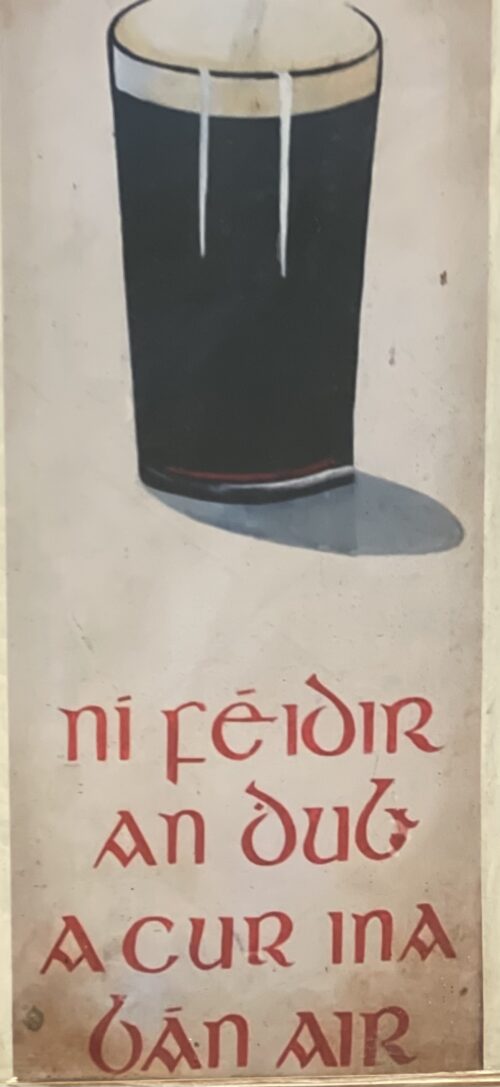
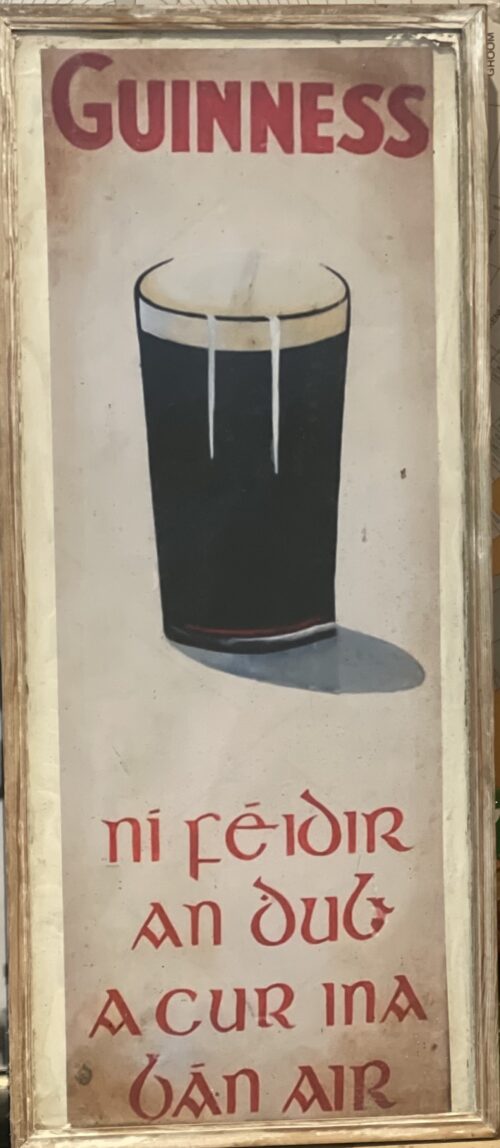 65cm x 42cm Arthur Guinness started brewing ales in 1759 at the St James Gate Brewery,Dublin.On 31st December 1759 he signed a 9,000 year lease at £45 per annum for the unused brewery.Ten years later, on 19 May 1769, Guinness first exported his ale: he shipped six-and-a-half barrels to Great Britain before he started selling the dark beer porter in 1778. The first Guinness beers to use the term were Single Stout and Double Stout in the 1840s.Throughout the bulk of its history, Guinness produced only three variations of a single beer type: porter or single stout, double or extra and foreign stout for export. “Stout” originally referred to a beer’s strength, but eventually shifted meaning toward body and colour.Porter was also referred to as “plain”, as mentioned in the famous refrain of Flann O’Brien‘s poem “The Workman’s Friend”: “A pint of plain is your only man.” Already one of the top-three British and Irish brewers, Guinness’s sales soared from 350,000 barrels in 1868 to 779,000 barrels in 1876.In October 1886 Guinness became a public company, and was averaging sales of 1,138,000 barrels a year. This was despite the brewery’s refusal to either advertise or offer its beer at a discount. Even though Guinness owned no public houses, the company was valued at £6 million and shares were twenty times oversubscribed, with share prices rising to a 60 per cent premium on the first day of trading. The breweries pioneered several quality control efforts. The brewery hired the statistician William Sealy Gosset in 1899, who achieved lasting fame under the pseudonym “Student” for techniques developed for Guinness, particularly Student’s t-distribution and the even more commonly known Student’s t-test. By 1900 the brewery was operating unparalleled welfare schemes for its 5,000 employees. By 1907 the welfare schemes were costing the brewery £40,000 a year, which was one-fifth of the total wages bill. The improvements were suggested and supervised by Sir John Lumsden. By 1914, Guinness was producing 2,652,000 barrels of beer a year, which was more than double that of its nearest competitor Bass, and was supplying more than 10 per cent of the total UK beer market. In the 1930s, Guinness became the seventh largest company in the world. Before 1939, if a Guinness brewer wished to marry a Catholic, his resignation was requested. According to Thomas Molloy, writing in the Irish Independent, “It had no qualms about selling drink to Catholics but it did everything it could to avoid employing them until the 1960s.” Guinness thought they brewed their last porter in 1973. In the 1970s, following declining sales, the decision was taken to make Guinness Extra Stout more “drinkable”. The gravity was subsequently reduced, and the brand was relaunched in 1981. Pale malt was used for the first time, and isomerized hop extract began to be used. In 2014, two new porters were introduced: West Indies Porter and Dublin Porter. Guinness acquired the Distillers Company in 1986.This led to a scandal and criminal trialconcerning the artificial inflation of the Guinness share price during the takeover bid engineered by the chairman, Ernest Saunders. A subsequent £5.2 million success fee paid to an American lawyer and Guinness director, Tom Ward, was the subject of the case Guinness plc v Saunders, in which the House of Lords declared that the payment had been invalid. In the 1980s, as the IRA’s bombing campaign spread to London and the rest of Britain, Guinness considered scrapping the Harp as its logo. The company merged with Grand Metropolitan in 1997 to form Diageo. Due to controversy over the merger, the company was maintained as a separate entity within Diageo and has retained the rights to the product and all associated trademarks of Guinness.The Guinness brewery in Park Royal, London closed in 2005. The production of all Guinness sold in the UK and Ireland was moved to St. James’s Gate Brewery, Dublin. Guinness has also been referred to as “that black stuff”. Guinness had a fleet of ships, barges and yachts. The Irish Sunday Independent newspaper reported on 17 June 2007 that Diageo intended to close the historic St James’s Gate plant in Dublin and move to a greenfield site on the outskirts of the city.This news caused some controversy when it was announced.The following day, the Irish Daily Mail ran a follow-up story with a double page spread complete with images and a history of the plant since 1759. Initially, Diageo said that talk of a move was pure speculation but in the face of mounting speculation in the wake of the Sunday Independent article, the company confirmed that it is undertaking a “significant review of its operations”. This review was largely due to the efforts of the company’s ongoing drive to reduce the environmental impact of brewing at the St James’s Gate plant. On 23 November 2007, an article appeared in the Evening Herald, a Dublin newspaper, stating that the Dublin City Council, in the best interests of the city of Dublin, had put forward a motion to prevent planning permission ever being granted for development of the site, thus making it very difficult for Diageo to sell off the site for residential development. On 9 May 2008, Diageo announced that the St James’s Gate brewery will remain open and undergo renovations, but that breweries in Kilkenny and Dundalk will be closed by 2013 when a new larger brewery is opened near Dublin. The result will be a loss of roughly 250 jobs across the entire Diageo/Guinness workforce in Ireland.Two days later, the Sunday Independent again reported that Diageo chiefs had met with Tánaiste Mary Coughlan, the deputy leader of the Government of Ireland, about moving operations to Ireland from the UK to benefit from its lower corporation tax rates. Several UK firms have made the move in order to pay Ireland’s 12.5 per cent rate rather than the UK’s 28 per cent rate. Diageo released a statement to the London stock exchange denying the report.Despite the merger that created Diageo plc in 1997, Guinness has retained its right to the Guinness brand and associated trademarks and thus continues to trade under the traditional Guinness name despite trading under the corporation name Diageo for a brief period in 1997. In November 2015 it was announced that Guinness are planning to make their beer suitable for consumption by vegetarians and vegans by the end of 2016 through the introduction of a new filtration process at their existing Guinness Brewery that avoids the need to use isinglass from fish bladders to filter out yeast particles.This went into effect in 2017, per the company’s FAQ webpage where they state: “Our new filtration process has removed the use of isinglass as a means of filtration and vegans can now enjoy a pint of Guinness. All Guinness Draught in keg format is brewed without using isinglass. Full distribution of bottle and can formats will be in place by the end of 2017, so until then, our advice to vegans is to consume the product from the keg format only for now. Guinness stout is made from water, barley, roast malt extract, hops, and brewer’s yeast. A portion of the barley is roasted to give Guinness its dark colour and characteristic taste. It is pasteurisedand filtered. Until the late 1950s Guinness was still racked into wooden casks. In the late 1950s and early 1960s, Guinness ceased brewing cask-conditioned beers and developed a keg brewing system with aluminium kegs replacing the wooden casks; these were nicknamed “iron lungs”.Until 2016 the production of Guinness, as with many beers, involved the use of isinglass made from fish. Isinglass was used as a fining agent for settling out suspended matter in the vat. The isinglass was retained in the floor of the vat but it was possible that minute quantities might be carried over into the beer. Diageo announced in February 2018 that the use of isinglass in draught Guinness was to be discontinued and an alternative clarification agent would be used instead. This has made draught Guinness acceptable to vegans and vegetarians. Arguably its biggest change to date, in 1959 Guinness began using nitrogen, which changed the fundamental texture and flavour of the Guinness of the past as nitrogen bubbles are much smaller than CO2, giving a “creamier” and “smoother” consistency over a sharper and traditional CO2 taste. This step was taken after Michael Ash – a mathematician turned brewer – discovered the mechanism to make this possible. Nitrogen is less soluble than carbon dioxide, which allows the beer to be put under high pressure without making it fizzy. High pressure of the dissolved gas is required to enable very small bubbles to be formed by forcing the draught beer through fine holes in a plate in the tap, which causes the characteristic “surge” (the widget in cans and bottles achieves the same effect). This “widget” is a small plastic ball containing the nitrogen. The perceived smoothness of draught Guinness is due to its low level of carbon dioxide and the creaminess of the head caused by the very fine bubbles that arise from the use of nitrogen and the dispensing method described above. “Foreign Extra Stout” contains more carbon dioxide, causing a more acidic taste. Contemporary Guinness Draught and Extra Stout are weaker than they were in the 19th century, when they had an original gravity of over 1.070. Foreign Extra Stout and Special Export Stout, with abv of 7.5% and 9% respectively, are perhaps closest to the original in character.Although Guinness may appear to be black, it is officially a very dark shade of ruby. The most recent change in alcohol content from the Import Stout to the Extra Stout was due to a change in distribution through North American market. Consumer complaints have influenced recent distribution and bottle changes. Studies claim that Guinness can be beneficial to the heart. Researchers found that “‘antioxidantcompounds’ in the Guinness, similar to those found in certain fruits and vegetables, are responsible for the health benefits because they slow down the deposit of harmful cholesterol on the artery walls.”Guinness ran an advertising campaign in the 1920s which stemmed from market research – when people told the company that they felt good after their pint, the slogan, created by Dorothy L. Sayers–”Guinness is Good for You”. Advertising for alcoholic drinks that implies improved physical performance or enhanced personal qualities is now prohibited in Ireland.Diageo, the company that now manufactures Guinness, says: “We never make any medical claims for our drinks.”
65cm x 42cm Arthur Guinness started brewing ales in 1759 at the St James Gate Brewery,Dublin.On 31st December 1759 he signed a 9,000 year lease at £45 per annum for the unused brewery.Ten years later, on 19 May 1769, Guinness first exported his ale: he shipped six-and-a-half barrels to Great Britain before he started selling the dark beer porter in 1778. The first Guinness beers to use the term were Single Stout and Double Stout in the 1840s.Throughout the bulk of its history, Guinness produced only three variations of a single beer type: porter or single stout, double or extra and foreign stout for export. “Stout” originally referred to a beer’s strength, but eventually shifted meaning toward body and colour.Porter was also referred to as “plain”, as mentioned in the famous refrain of Flann O’Brien‘s poem “The Workman’s Friend”: “A pint of plain is your only man.” Already one of the top-three British and Irish brewers, Guinness’s sales soared from 350,000 barrels in 1868 to 779,000 barrels in 1876.In October 1886 Guinness became a public company, and was averaging sales of 1,138,000 barrels a year. This was despite the brewery’s refusal to either advertise or offer its beer at a discount. Even though Guinness owned no public houses, the company was valued at £6 million and shares were twenty times oversubscribed, with share prices rising to a 60 per cent premium on the first day of trading. The breweries pioneered several quality control efforts. The brewery hired the statistician William Sealy Gosset in 1899, who achieved lasting fame under the pseudonym “Student” for techniques developed for Guinness, particularly Student’s t-distribution and the even more commonly known Student’s t-test. By 1900 the brewery was operating unparalleled welfare schemes for its 5,000 employees. By 1907 the welfare schemes were costing the brewery £40,000 a year, which was one-fifth of the total wages bill. The improvements were suggested and supervised by Sir John Lumsden. By 1914, Guinness was producing 2,652,000 barrels of beer a year, which was more than double that of its nearest competitor Bass, and was supplying more than 10 per cent of the total UK beer market. In the 1930s, Guinness became the seventh largest company in the world. Before 1939, if a Guinness brewer wished to marry a Catholic, his resignation was requested. According to Thomas Molloy, writing in the Irish Independent, “It had no qualms about selling drink to Catholics but it did everything it could to avoid employing them until the 1960s.” Guinness thought they brewed their last porter in 1973. In the 1970s, following declining sales, the decision was taken to make Guinness Extra Stout more “drinkable”. The gravity was subsequently reduced, and the brand was relaunched in 1981. Pale malt was used for the first time, and isomerized hop extract began to be used. In 2014, two new porters were introduced: West Indies Porter and Dublin Porter. Guinness acquired the Distillers Company in 1986.This led to a scandal and criminal trialconcerning the artificial inflation of the Guinness share price during the takeover bid engineered by the chairman, Ernest Saunders. A subsequent £5.2 million success fee paid to an American lawyer and Guinness director, Tom Ward, was the subject of the case Guinness plc v Saunders, in which the House of Lords declared that the payment had been invalid. In the 1980s, as the IRA’s bombing campaign spread to London and the rest of Britain, Guinness considered scrapping the Harp as its logo. The company merged with Grand Metropolitan in 1997 to form Diageo. Due to controversy over the merger, the company was maintained as a separate entity within Diageo and has retained the rights to the product and all associated trademarks of Guinness.The Guinness brewery in Park Royal, London closed in 2005. The production of all Guinness sold in the UK and Ireland was moved to St. James’s Gate Brewery, Dublin. Guinness has also been referred to as “that black stuff”. Guinness had a fleet of ships, barges and yachts. The Irish Sunday Independent newspaper reported on 17 June 2007 that Diageo intended to close the historic St James’s Gate plant in Dublin and move to a greenfield site on the outskirts of the city.This news caused some controversy when it was announced.The following day, the Irish Daily Mail ran a follow-up story with a double page spread complete with images and a history of the plant since 1759. Initially, Diageo said that talk of a move was pure speculation but in the face of mounting speculation in the wake of the Sunday Independent article, the company confirmed that it is undertaking a “significant review of its operations”. This review was largely due to the efforts of the company’s ongoing drive to reduce the environmental impact of brewing at the St James’s Gate plant. On 23 November 2007, an article appeared in the Evening Herald, a Dublin newspaper, stating that the Dublin City Council, in the best interests of the city of Dublin, had put forward a motion to prevent planning permission ever being granted for development of the site, thus making it very difficult for Diageo to sell off the site for residential development. On 9 May 2008, Diageo announced that the St James’s Gate brewery will remain open and undergo renovations, but that breweries in Kilkenny and Dundalk will be closed by 2013 when a new larger brewery is opened near Dublin. The result will be a loss of roughly 250 jobs across the entire Diageo/Guinness workforce in Ireland.Two days later, the Sunday Independent again reported that Diageo chiefs had met with Tánaiste Mary Coughlan, the deputy leader of the Government of Ireland, about moving operations to Ireland from the UK to benefit from its lower corporation tax rates. Several UK firms have made the move in order to pay Ireland’s 12.5 per cent rate rather than the UK’s 28 per cent rate. Diageo released a statement to the London stock exchange denying the report.Despite the merger that created Diageo plc in 1997, Guinness has retained its right to the Guinness brand and associated trademarks and thus continues to trade under the traditional Guinness name despite trading under the corporation name Diageo for a brief period in 1997. In November 2015 it was announced that Guinness are planning to make their beer suitable for consumption by vegetarians and vegans by the end of 2016 through the introduction of a new filtration process at their existing Guinness Brewery that avoids the need to use isinglass from fish bladders to filter out yeast particles.This went into effect in 2017, per the company’s FAQ webpage where they state: “Our new filtration process has removed the use of isinglass as a means of filtration and vegans can now enjoy a pint of Guinness. All Guinness Draught in keg format is brewed without using isinglass. Full distribution of bottle and can formats will be in place by the end of 2017, so until then, our advice to vegans is to consume the product from the keg format only for now. Guinness stout is made from water, barley, roast malt extract, hops, and brewer’s yeast. A portion of the barley is roasted to give Guinness its dark colour and characteristic taste. It is pasteurisedand filtered. Until the late 1950s Guinness was still racked into wooden casks. In the late 1950s and early 1960s, Guinness ceased brewing cask-conditioned beers and developed a keg brewing system with aluminium kegs replacing the wooden casks; these were nicknamed “iron lungs”.Until 2016 the production of Guinness, as with many beers, involved the use of isinglass made from fish. Isinglass was used as a fining agent for settling out suspended matter in the vat. The isinglass was retained in the floor of the vat but it was possible that minute quantities might be carried over into the beer. Diageo announced in February 2018 that the use of isinglass in draught Guinness was to be discontinued and an alternative clarification agent would be used instead. This has made draught Guinness acceptable to vegans and vegetarians. Arguably its biggest change to date, in 1959 Guinness began using nitrogen, which changed the fundamental texture and flavour of the Guinness of the past as nitrogen bubbles are much smaller than CO2, giving a “creamier” and “smoother” consistency over a sharper and traditional CO2 taste. This step was taken after Michael Ash – a mathematician turned brewer – discovered the mechanism to make this possible. Nitrogen is less soluble than carbon dioxide, which allows the beer to be put under high pressure without making it fizzy. High pressure of the dissolved gas is required to enable very small bubbles to be formed by forcing the draught beer through fine holes in a plate in the tap, which causes the characteristic “surge” (the widget in cans and bottles achieves the same effect). This “widget” is a small plastic ball containing the nitrogen. The perceived smoothness of draught Guinness is due to its low level of carbon dioxide and the creaminess of the head caused by the very fine bubbles that arise from the use of nitrogen and the dispensing method described above. “Foreign Extra Stout” contains more carbon dioxide, causing a more acidic taste. Contemporary Guinness Draught and Extra Stout are weaker than they were in the 19th century, when they had an original gravity of over 1.070. Foreign Extra Stout and Special Export Stout, with abv of 7.5% and 9% respectively, are perhaps closest to the original in character.Although Guinness may appear to be black, it is officially a very dark shade of ruby. The most recent change in alcohol content from the Import Stout to the Extra Stout was due to a change in distribution through North American market. Consumer complaints have influenced recent distribution and bottle changes. Studies claim that Guinness can be beneficial to the heart. Researchers found that “‘antioxidantcompounds’ in the Guinness, similar to those found in certain fruits and vegetables, are responsible for the health benefits because they slow down the deposit of harmful cholesterol on the artery walls.”Guinness ran an advertising campaign in the 1920s which stemmed from market research – when people told the company that they felt good after their pint, the slogan, created by Dorothy L. Sayers–”Guinness is Good for You”. Advertising for alcoholic drinks that implies improved physical performance or enhanced personal qualities is now prohibited in Ireland.Diageo, the company that now manufactures Guinness, says: “We never make any medical claims for our drinks.” -

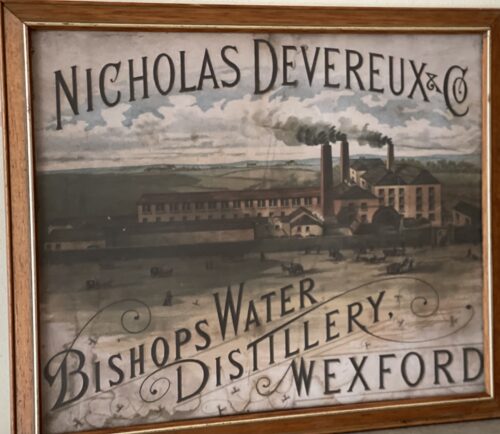 40cm x 34cm LimerickBishops Water Distillery(subsequently known as Nicholas Devereux Finest Irish Whisky) was an Irish whiskey distillery which operated in Wexford, Ireland between 1827 and 1914. The distillery was named for a stream which ran along the back of the distillery, the Bishop's Water, said to possess "various occult properties derived from the blessings of the sainted Bishop of Ferns". Constructed at a cost of £30,000, the distillery was reported to be “reckoned the most perfect and complete of the kind in Ireland”.In 1833, just a few years after it opened, the distillery recorded an output of about 200,000 gallons per annum .However, output had fallen to just 110,000 gallons per annum in 1886, when the distillery was visited by Alfred Barnard, as recorded in his seminal 1887 publication "The Whisky Distilleries of the United Kingdom". This was amongst the lowest output of any distillery operating in Ireland at the time, and far below the potential output of 250,000 gallons per annum reported when the distillery was offered for sale as a going concern in 1909. The distillery's whiskey, Barnard noted, was highly appreciated locally, and in the British cities where it was exported. In the early 20th century, with the Irish whiskey industry in decline, Bishop's Water distillery, like the majority of distilleries in Ireland at the time, suffered serious financial difficulties, and entered bankruptcy. Following its closure, the distillery was initially converted into an iron works (Pierce Ironworks). However, much of the site was later demolished, and little evidence of the distillery still remains. Some mementos can still be found in locals pubs, while a stone archway known to have been extant in 1903 and now bearing the inscription "Casa Rio", possibly in reference to the location of a Pierce ironworks office in Buenos Aires, marks the entrance to the site where the distillery once stood, on Distillery Road. In 1827, a whiskey distillery was established on what is now Distillery Road, Wexford by a consortium of businessmen. The consortium which traded under "Devereux, Harvey, and Co., Distillers", comprised a number of local businessmen, including Nicholas Devereux, his father John Devereux, and Maurice Crosbie Harvey. John Devereux had previously operated a small distillery in the area in the late 1700s, but will little success. In 1830, one of the partners, Maurice Harvey, was accidentally killed at the distillery by an excise man who was taking aim at some birds flying overhead. A few years later, in 1836, the partnership was dissolved at the mutual consent of the remaining partners, with Nicholas Devereux taking sole ownership of the distillery, after which the distillery traded under the name Nicholas Devereux & Son.On his death in 1840, operation of the distillery was taken over by his son Richard. Nichloas Devereux's granddaughter, Mary Anne Therese was also deeply involving in the distilling industry. She married John Locke, founder of the larger Kilbeggan distillery, and successfully took over the business operations of the distillery on his death in 1868. According to Alfred Barnard, the British journalist who visited Bishop's Water in the 1880s, the distillery produced triple-distilled "old pot still whiskey", which was sold locally in Ireland, and also exported to London, Liverpool, and Bristol. At the time of his visit, the Malt Warehouses on-site contained over 16,000 barrels of pure malt. In addition, upwards of 3,000 casks of whiskey were undergoing maturation at the distillery. Whiskey from the distillery is also noted to have been used in the production of blended whiskeys in later years. In the early 20th century, the distillery suffered financial difficulties. In 1907, an attempt was made to appoint a receiver, and in 1909, the distillery was put up for sale, but no takers could be found.In 1914, distilling eventually ceased at the site, and the remaining stocks were sold off.
40cm x 34cm LimerickBishops Water Distillery(subsequently known as Nicholas Devereux Finest Irish Whisky) was an Irish whiskey distillery which operated in Wexford, Ireland between 1827 and 1914. The distillery was named for a stream which ran along the back of the distillery, the Bishop's Water, said to possess "various occult properties derived from the blessings of the sainted Bishop of Ferns". Constructed at a cost of £30,000, the distillery was reported to be “reckoned the most perfect and complete of the kind in Ireland”.In 1833, just a few years after it opened, the distillery recorded an output of about 200,000 gallons per annum .However, output had fallen to just 110,000 gallons per annum in 1886, when the distillery was visited by Alfred Barnard, as recorded in his seminal 1887 publication "The Whisky Distilleries of the United Kingdom". This was amongst the lowest output of any distillery operating in Ireland at the time, and far below the potential output of 250,000 gallons per annum reported when the distillery was offered for sale as a going concern in 1909. The distillery's whiskey, Barnard noted, was highly appreciated locally, and in the British cities where it was exported. In the early 20th century, with the Irish whiskey industry in decline, Bishop's Water distillery, like the majority of distilleries in Ireland at the time, suffered serious financial difficulties, and entered bankruptcy. Following its closure, the distillery was initially converted into an iron works (Pierce Ironworks). However, much of the site was later demolished, and little evidence of the distillery still remains. Some mementos can still be found in locals pubs, while a stone archway known to have been extant in 1903 and now bearing the inscription "Casa Rio", possibly in reference to the location of a Pierce ironworks office in Buenos Aires, marks the entrance to the site where the distillery once stood, on Distillery Road. In 1827, a whiskey distillery was established on what is now Distillery Road, Wexford by a consortium of businessmen. The consortium which traded under "Devereux, Harvey, and Co., Distillers", comprised a number of local businessmen, including Nicholas Devereux, his father John Devereux, and Maurice Crosbie Harvey. John Devereux had previously operated a small distillery in the area in the late 1700s, but will little success. In 1830, one of the partners, Maurice Harvey, was accidentally killed at the distillery by an excise man who was taking aim at some birds flying overhead. A few years later, in 1836, the partnership was dissolved at the mutual consent of the remaining partners, with Nicholas Devereux taking sole ownership of the distillery, after which the distillery traded under the name Nicholas Devereux & Son.On his death in 1840, operation of the distillery was taken over by his son Richard. Nichloas Devereux's granddaughter, Mary Anne Therese was also deeply involving in the distilling industry. She married John Locke, founder of the larger Kilbeggan distillery, and successfully took over the business operations of the distillery on his death in 1868. According to Alfred Barnard, the British journalist who visited Bishop's Water in the 1880s, the distillery produced triple-distilled "old pot still whiskey", which was sold locally in Ireland, and also exported to London, Liverpool, and Bristol. At the time of his visit, the Malt Warehouses on-site contained over 16,000 barrels of pure malt. In addition, upwards of 3,000 casks of whiskey were undergoing maturation at the distillery. Whiskey from the distillery is also noted to have been used in the production of blended whiskeys in later years. In the early 20th century, the distillery suffered financial difficulties. In 1907, an attempt was made to appoint a receiver, and in 1909, the distillery was put up for sale, but no takers could be found.In 1914, distilling eventually ceased at the site, and the remaining stocks were sold off. -
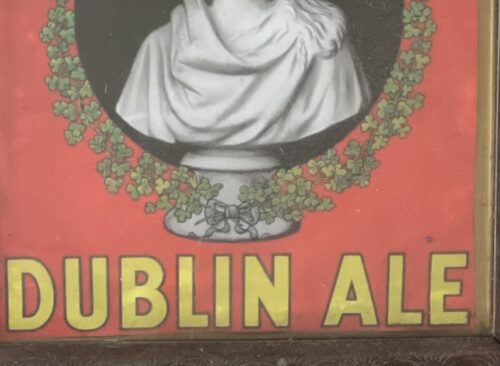
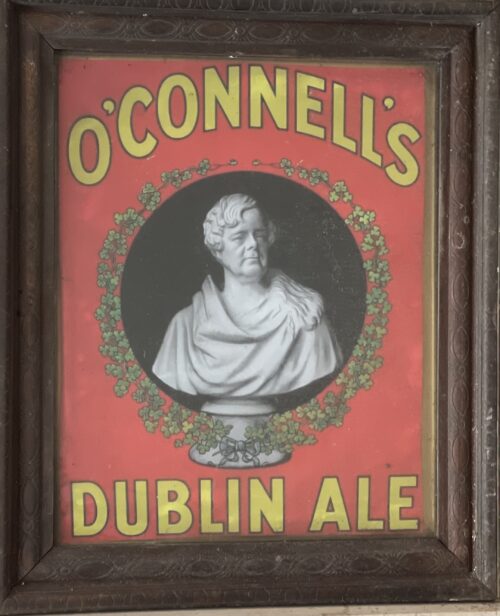 67cm x 56cm
67cm x 56cmDaniel O’Connnell Jr. had famously acquired the Phoenix Brewery in James’s street in 1831, which produced O’Connell’s Ale. It should be noted that O’Connell and the Guinness family were at times political rivals, something best captured by the 1841 ‘Repeal Election’, where O’Connell had stood against and defeated Arthur Guinness Jr. This period would see a sizeable boycott of Guinness, dubbed “Protestant Porter” by sections of the populace, though this was against the wishes of O’Connell himself.
John D’Arcy continued to brew O’Connell Ale after the family had ceased their role in brewing, and in time production moved to the Anchor Brewery in Usher Street. Watkins eventually took up the brewing of O’Connell Ale, and this advertisement was placed by them in the pages of leading newspapers in the 1930s.
While Arthur had failed to defeat O’Connell at the Ballot Box, I always wonder what O’Connell would think of the Guinness Empire today every time I see a Diaego truck pass his statue.
-

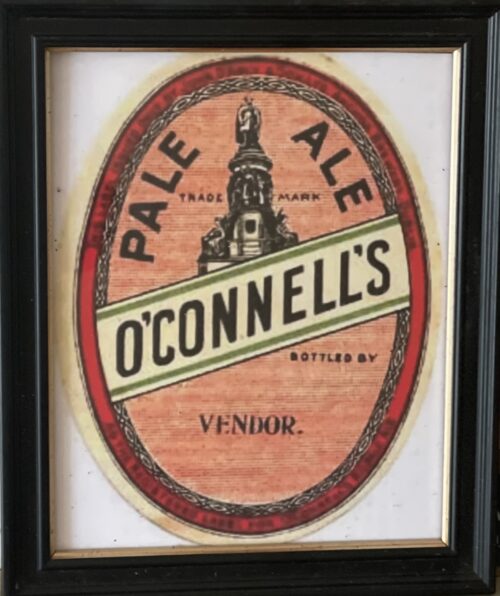 32cm x 27cm
32cm x 27cmDaniel O’Connnell Jr. had famously acquired the Phoenix Brewery in James’s street in 1831, which produced O’Connell’s Ale. It should be noted that O’Connell and the Guinness family were at times political rivals, something best captured by the 1841 ‘Repeal Election’, where O’Connell had stood against and defeated Arthur Guinness Jr. This period would see a sizeable boycott of Guinness, dubbed “Protestant Porter” by sections of the populace, though this was against the wishes of O’Connell himself.
John D’Arcy continued to brew O’Connell Ale after the family had ceased their role in brewing, and in time production moved to the Anchor Brewery in Usher Street. Watkins eventually took up the brewing of O’Connell Ale, and this advertisement was placed by them in the pages of leading newspapers in the 1930s.
While Arthur had failed to defeat O’Connell at the Ballot Box, I always wonder what O’Connell would think of the Guinness Empire today every time I see a Diaego truck pass his statue.
-

 47cm x 37cm LimerickMuch of the last century, and indeed for well over half of the present one, Limerick's importance was directly attributed to her three well-known bacon factories, namely, J. Matterson & Sons, Roches Street, established in 1816 by Mr. John Russell, a Cumberland man in con-junction with Mr. Matterson, using the method of curing then current in Berwick-on-Tweed. W.J. Shaw & Sons, founded in the year 1831 at Mulgrave Street by William John Shaw, a descendant of a County Down family, and O'Mara's bacon factory, Roches Street, which had its origin in Mungret Street some few years before 1839, when James O'Mara from Toomevara started curing bacon in the basement of his house there. Apparently, this basement business flourished, for in 1839 he moved to Roches Street to the premises it last occupied .About the middle of the last century, for some reason now difficult to fathom, Limerick bacon and especially Limerick hams, became well-known for their excellent flavour throughout the English-speaking world. It is on record that Glasgow curers in an effort to produce hams equal in excellence to those of Limerick, imported Limerick workmen who were supposed to know all about the way in which the meat was turned out at home. Apparently, they did not bring secrets with them for their efforts were unsuccessful. There were also much larger bacon factories in parts of the British Isles; for instance, Belfast is reputed to have exported four times the number of hams produced in Limerick, and places like Glasgow and Liverpool had several factories producing very large quantities of bacon as well. None of them, however, quite matched' those produced in the three local factories for flavour and quality.O’MARA’S, MATTERSON’S, SHAW’S and Denny’s were the names that made Limerick famous for its bacon produce for 180 years – earning it the nickname ‘Pigstown’. The reputation of Limerick ham, the food culture that arose from a plentiful supply of cheap products, the story of the pork butchers, the pig buyers, the sounds of the city with factory horns signalling the call to work – all of these still resonate in Limerick in the memories of its citizens and former workers. A definitive account of this industry that operated at the centre of the city, supplied by the farms of rural county Limerick for over 180 years will be documented in a new book called Pigtown – A History of Limerick’s Bacon Industry. Ruth Guiry was commissioned to undertake the research under the guidance of Dr Maura Cronin from Mary Immaculate College and one of the 27 people she interviewed to understand the role the bacon factories had in Limerick was Joe Hayes. Joe Hayes started working in a bacon factory in 1962, aged 16 years old. He worked with his dad, and later on with his two sons until the factory closed in 1986. “When the factory closed, a group of us got our own little unit, we rented it, and produced our own sausages, puddings and things.” It was a huge part of Limerick’s social scene: four generations of Joe’s family worked in bacon factories, with uncles, sisters, brothers, sons and cousins all working in the factory at one time or another: “If one factory was caic, you wouldn’t have a problem getting a job in the other one. And he doesn’t mince his word when talking about the work they did. “They brought the pigs in, we killed the pigs, and prepared the bacon: that’s the way it was in the bacon factories.” When asked about if there were ever animal cruelty protests, he laughs at the idea.
47cm x 37cm LimerickMuch of the last century, and indeed for well over half of the present one, Limerick's importance was directly attributed to her three well-known bacon factories, namely, J. Matterson & Sons, Roches Street, established in 1816 by Mr. John Russell, a Cumberland man in con-junction with Mr. Matterson, using the method of curing then current in Berwick-on-Tweed. W.J. Shaw & Sons, founded in the year 1831 at Mulgrave Street by William John Shaw, a descendant of a County Down family, and O'Mara's bacon factory, Roches Street, which had its origin in Mungret Street some few years before 1839, when James O'Mara from Toomevara started curing bacon in the basement of his house there. Apparently, this basement business flourished, for in 1839 he moved to Roches Street to the premises it last occupied .About the middle of the last century, for some reason now difficult to fathom, Limerick bacon and especially Limerick hams, became well-known for their excellent flavour throughout the English-speaking world. It is on record that Glasgow curers in an effort to produce hams equal in excellence to those of Limerick, imported Limerick workmen who were supposed to know all about the way in which the meat was turned out at home. Apparently, they did not bring secrets with them for their efforts were unsuccessful. There were also much larger bacon factories in parts of the British Isles; for instance, Belfast is reputed to have exported four times the number of hams produced in Limerick, and places like Glasgow and Liverpool had several factories producing very large quantities of bacon as well. None of them, however, quite matched' those produced in the three local factories for flavour and quality.O’MARA’S, MATTERSON’S, SHAW’S and Denny’s were the names that made Limerick famous for its bacon produce for 180 years – earning it the nickname ‘Pigstown’. The reputation of Limerick ham, the food culture that arose from a plentiful supply of cheap products, the story of the pork butchers, the pig buyers, the sounds of the city with factory horns signalling the call to work – all of these still resonate in Limerick in the memories of its citizens and former workers. A definitive account of this industry that operated at the centre of the city, supplied by the farms of rural county Limerick for over 180 years will be documented in a new book called Pigtown – A History of Limerick’s Bacon Industry. Ruth Guiry was commissioned to undertake the research under the guidance of Dr Maura Cronin from Mary Immaculate College and one of the 27 people she interviewed to understand the role the bacon factories had in Limerick was Joe Hayes. Joe Hayes started working in a bacon factory in 1962, aged 16 years old. He worked with his dad, and later on with his two sons until the factory closed in 1986. “When the factory closed, a group of us got our own little unit, we rented it, and produced our own sausages, puddings and things.” It was a huge part of Limerick’s social scene: four generations of Joe’s family worked in bacon factories, with uncles, sisters, brothers, sons and cousins all working in the factory at one time or another: “If one factory was caic, you wouldn’t have a problem getting a job in the other one. And he doesn’t mince his word when talking about the work they did. “They brought the pigs in, we killed the pigs, and prepared the bacon: that’s the way it was in the bacon factories.” When asked about if there were ever animal cruelty protests, he laughs at the idea.
They started at 8am and finished at 5.30 working a 40 hour week when the factory closed in 1986, but despite their work, the people who worked in factories often couldn’t afford to buy the expensive cuts of meat. After the expensive cuts were prepared, the offal, the spare ribs, the pigs’ heads would go to the poorer people. “The blood was used to make the pudding, the packet, the tripe was made off the belly. Everything was used off the pig, and it fed Limerick city.” It was a way of life down in Limerick, so when the factories closed, thousands of people working in a bacon factories were out of jobs, and thousands of families were affected. But it wasn’t the competition from big supermarkets that did it – it was free trade. The Danes, the French, the Dutch all started exporting their products here, and Limerick factories didn’t have the money to export to compete. “Michael O’Mara’s funeral was this week – he was the last of the bacon factory managers.” says Joe. “After the Limerick factory closed, he tried doing different bits and pieces, but nothing worked out for him, so he worked in a factory for a couple of years before retiring.” Joe Hayes himself is retired now, and when he buys his meat he gets it in a supermarket. “Meat is meat,” he says.”But if I see the tricolour flag, I’ll still buy it even if it’s dearer.” Pigtown - A History of Limerick’s Bacon Industry by Ruth Guiry is co-edited by Dr Maura Cronin and Jacqui Hayes.People still eat sausages and bacon – where do they think they come from?

 Some original and rare Mitchell mirrors are still surviving today and can be found in some pubs in and around Belfast today
Some original and rare Mitchell mirrors are still surviving today and can be found in some pubs in and around Belfast today
 Some other examples of Mitchell Mirrors which were mass produced for advertising their products
Some other examples of Mitchell Mirrors which were mass produced for advertising their products




